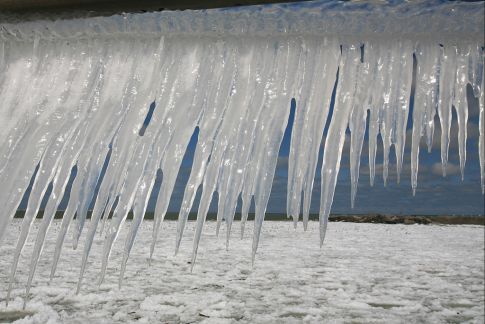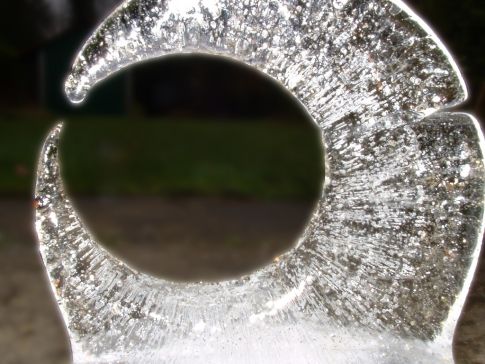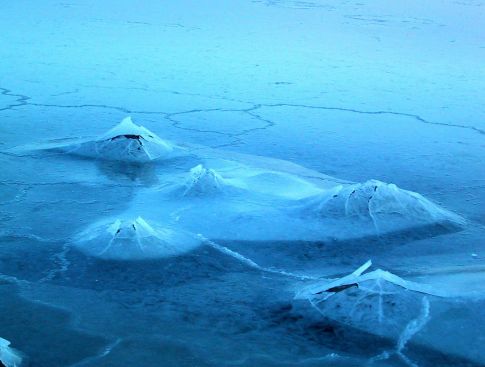
Winter is icumen in, as Ezra Pound quipped, and it's all about the ice.
Fall is already making the trees crisp and soon enough the streets around Boston will resemble the dirty hearts of comets--one of which, by the way, has recently been confirmed to be carrying glycine. That in itself isn't a huge shock; we already knew amino acids were present in meteorites. But this discovery adds a new mechanism by which the raw stuff of life may be transported among worlds, seeding the viable ones for future evolution.
On that subject, there is some interesting commentary this month from Elon Musk of Tesla Motors and SpaceX, who sees humanity as having a certain "obligation" to plant life around the solar system. We are -- paraphrasing his words -- the representatives of the biosphere, the one branch of the evolutionary tree that can secure the whole against the next extinction. It may also be - my words now -- that there is a small window of opportunity through which technological civilization must pass before it is erased; dither and mother nature starts again. Indeed, specifying the exact aperture of that window may be the correct solution to the Fermi Paradox.
SpaceX is involved with the ISS, NASA, the Air Force, and advocates starting colonies on Mars, in part as a failsafe in case asteroids, plague or fanatics abruptly end homo sapiens' tenure on Earth. If there is no life anywhere else in the galaxy -- unlikely, but entirely consistent with present data -- perhaps we should begin taking this obligation with a bit more of the cosmic significance it may, in fact, bear.
And speaking of our red neighbor, surface ice was just spotted there by NASA's Mars Reconnaissance Orbiter. (Subsurface ice has already been sensed.) It was a lucky shot; MRO imaged a "bluish" crater in the "Cebrenia quadrangle," causing analysts to suspect water ice, all of which had sublimated into the atmosphere once more within a few months of the initial fly-over. Look for the report in Science.
A little closer to home, another Reconnaissance Orbiter -- this time of the Lunar variety -- has found the coldest spot on the moon. Indeed, as the popular science pieces all seem to say, it's the "coldest place in the solar system." (Wouldn't that more likely be a random comet on the far rim of the Oort Cloud? Or, for that matter, a piece of record-setting rhodium inside a cryogenics lab somewhere?) The super-chilly lunar location is within the permanently shaded craters on the South Pole, where the warmest it ever gets is a balmy -396 F.
From Christian Science Monitor:
"Ices of water, methane, or ammonia from ancient comet collisions would be well-preserved at the bottom of these lunar freezers. Such ices could be valuable resources that human lunar explorers could use. And they would help answer questions about the arrival of such "volatiles" to the Earth-moon system - evidence that Earth's geological processes have largely erased from its own surface."

Whenever humanity returns to the moon, we might be wise to park it at the rim of the Shackleton crater, where the top side is always in sunlight and the bottom is likely stocked with such ices, including the type one might thaw, split into its component parts, and use for rocket fuel. Or, I suppose, thaw, purify and drink. What a captivating notion that is: to sip a glass (or sealed squeeze bottle) of water that has never been part of Earth's hydrologic cycle at all, and may even have come from tens of thousands of AU away.
Meanwhile, down here our own glacial ice is melting at an increased rate. From PhysicsWorld:
"Scientists estimate that melting land ice is contributing 1.8 mm of the current 3.2 mm annual sea rise. In the latest report of the Intergovernmental Panel on Climate Change (IPCC) there is a worst-case scenario in which a 4 °C rise by 2090-2099 will result in an average sea-level rise of 0.26-0.59 m within the same period. The forecasted rise comes from a combination of melting ice sheets and the thermal expansion of sea waters . . ."
As if that weren't bad enough, the faster it melts . . . well, the faster it melts, in the alarming "runaway" scenario of glacial thaw:
"As the IPCC admit, however, their figures do not consider the potential of a runaway contribution from glaciers. Increasing melt along the lower part of the glacier can serve to lubricate the flow of ice into the sea and thus disturb the balance even further. The resultant "dynamic thinning" of glaciers has been tracked by using GPS and radar, but previous sensors have struggled to build a full extent of what is going on as it is difficult to resolve the faster-flowing coastal glaciers."
Bad news for all of us (except, apparently, roaches), though some will feel the effects of thawing ice and rising seas sooner, and more dramatically, than others.
Mars, Moon, and the beleaguered Earth. Any other ice this month? Only the icy stares among warring particle physicists at CERN . . .
